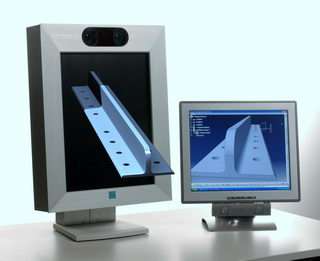3D display shows the design engineer’s projects and designs in 3D at the click of a button. © Fraunhofer HHI
Look down at the world from above - take a virtual stroll along narrow high-rise city streets and open squares. At CeBIT scientists from the Fraunhofer Institute for Telecommunications, Heinrich-Hertz-Institut HHI, are presenting a new 3D monitor that transforms the virtual outing into a unique experience - and not only for tourists.
Travelers often like to know in advance what to expect when they reach their destinations: How far is it from the airport or train station to the hotel? Which of the buildings along the way are particularly worth seeing? Is such-and-such a church worth a detour? Many of these things can be planned much more easily on a virtual tour of the city.
Programs like NASA World WIND or Google Earth offer a huge selection of cities, street plans and travel destinations. "The technology holds huge potential for development. The maps are constantly being updated, and cities can be viewed as textured 3D models with street plans superimposed on them. This gives travelers interesting information that could revolutionize vacation planning," says Rene de la Barre of the HHI.
When matched with the right optical system, virtual trips are even more impressive. De la Barre and his team of scientists are presenting a new 3D display at CeBIT specially designed for use as a travel aid. “We combined mixed reality technology with a tracking system. Our 30-inch monitor has a resolution of 1600 by 1200 pixels, or 1.9 million RGB pixels (red-green-blue) for each eye.
A camera determines the viewer's exact eye position in three coordinates and adapts the image very accurately to this visual angle. The images are presented in a high resolution,“ says the HHI expert, explaining the new technology. Visitors to CeBIT can test and enjoy the new 3D system for the first time, as it takes them through far-away cities.
A slightly modified version of the NASA World WIND program presently serves as the basis for the researchers' application. Users make their own way through the city or landscape using a touch-screen display. Travelers may soon be able to view their travel destinations in advance on 3D displays in major travel agencies, tourist information offices, convention centers or airports. Now the HHI researchers are thinking about developing their own program on the lines of NASA World Wind or Google Earth.
Source: Fraunhofer-Gesellschaft
























